IDA director Pawel Pawlikowski and cinematographer Lukasz Zal, PSC, watching the camera monitor
This post continues my in-depth look at scenes from the wonderful Polish film IDA. Once again I offer video and high-resolution images to present detailed examples of scene lighting.
This 2nd post is intended to be seen after you’ve read the 1st post:
3 Scenes from IDA.
Click on any image in this post to see a bigger version.
+++
IDA was directed by Pawel Pawlikowski, with cinematography by Lukasz Zal, PSC, and Ryszard Lynzewski, PSC. (Lukasz stepped in for Ryszard early on & shot most of the film.)
As I continued to discuss the lighting setups with Lukasz, he emphasized time and again that the images were the result of his collaboration with his director Pawel.
+++
video excerpt from IDA
The 3-minute video clip below occurs 58 minutes into the film. The sequence of six brief scenes conveys Ida questioning her decision to become a nun, upon returning to the convent after her travels with her worldly aunt Wanda.
Pawel Pawlikowski keeps his mise en scène here to a bare minimum, with no camera movement and few cuts. Each scene in this sequence also contains a brief poetic event that advances the story of Ida’s self-questioning: smelling a leaf, an open eye, a changing flame, a stifled laugh, a flickering candle, an upward look. IDA’s filmmaking masterfully combines economy and emotion.
+++
3 last scenes
Here we look at the last 3 scenes in the sequence. As mentioned in Part 1, Lukasz and Pawel sought to light IDA’s scenes simply, with single sources and natural lighting, and locked-down frames.
+++
dining room, night interior
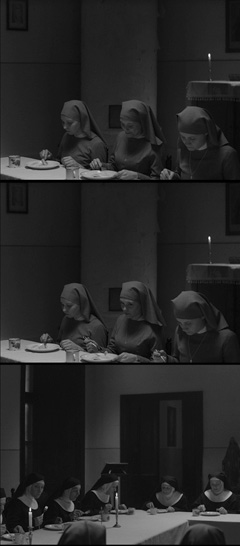 The scene is made of 2 shots, with subtle, underplayed action:
The scene is made of 2 shots, with subtle, underplayed action:
- a 3-shot of Ida flanked by novice nuns on each side.
- a wide shot of the Mother Superior looking at Ida, with 4 other nuns to her left.
As in much of the film, the framing leaves a lot of vertical space above the characters. This sky room is part of IDA’s distinctive look, and evokes both isolation below and inspiration from above.
Ida looks around and stifles a laugh. She briefly sees humor in her silent meal surrounded by nuns, revealing her estrangement from the convent setting. This moment of levity separates Ida from her companions who register surprise, and some disapproval. Ida then looks up, and glances camera left, aware of those looking at her.
We cut to a wider shot of five nuns, including the Mother Superior on the left, who eyes Ida intently.
Click on the film-strip images to see a larger version
Lukasz keyed the dining room interior with 2 Octodomes above the tables, to convey flat, institutional top lighting, the kind that could be provided by ceiling fluorescents. These 2 soft top light sources bounce off the white table cloth, creating a simple and elegant fill on the faces from below.
Lukasz’ lighting scheme involves a total of 7 lighting units.
In the first camera position:
- In the background, a candle is on a cupboard covered by a white cloth. A Dedolight spot is aimed on the cloth, to simulate candlelight. This bright background accent gives depth to the frame.
In the second camera position:
- A 6K outside creates a bright vertical glimpse of the window above the Mother Superior. The window was frosty, creating a nice sheen that bleeds softly on to the wall.
- A door in the background is open, showing a bit of wall lit by a Kino Flo.
Lukasz comments that adding background detail is a lesson learned from his fellow cinematographer and former teacher Ryszard Lynzewski.”Ryszard taught me that: whenever possible, open the space, show the windows, open the doors.”
- A third Octodome adds soft light to the far left corner, outlining a lectern in the background.
- A dimmed-down Dedolight adds a little exposure to a dark statue against the wall on camera right.
The candle on the table is merely decorative, and adds a bright accent to the top-lit interior.
The challenge of lighting this scene is not to make it beautiful, but to present ordinary, institutional top lighting, and still add some depth and accents to avoid a completely flat image.
+++
dormitory – night interior
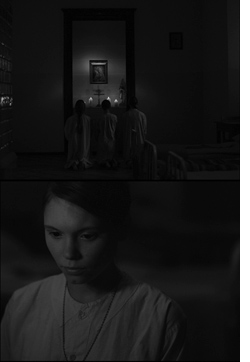 The dormitory scene is composed of 2 shots:
The dormitory scene is composed of 2 shots:
- A wide shot of the back of 3 novices praying in their dormitory in their nightgowns.
- A reverse close-up shot of Ida’s face lit by flickering candlelight.
We dimly hear the other novices praying, but Ida is silent, revealing her isolation. The flickering candlelight recalls the fire light in the kitchen, 2 scenes earlier in the sequence. But while the kitchen fire evoked sensuality and desire, the varying candle in the dormitory evokes Ida’s thoughtful uncertainty about becoming a nun.
![]()
Lukasz’s lighting required lowering sources to keep the 3 candles on the altar bright.
The candle’s key light is simulated by a Dedolight placed on the ground in front of the kneeling novices, and pointing upwards at the altar. This spot creates a shadow of the candles, which obviously cannot create their own shadows, but I feel that the lighting nevertheless succeeds in creating a feeling of strong candlelight. The decisive thing is the brightness of the area around the candles in the frame.
A 6K through a frame with 1/2 White gel outside the window provides a sidelight on the novices, defining them in the darkness. Lukasz notes that he had to pan the HMI fixture so as to get less light coming through the window, a technique he often uses to dim sources.
An Octodome above the camera provides general fill and defines the bed frames in the foreground from above.
For the close-up, Lukasz wanted natural candle light, so he put 6 candles on an apple box right below camera to light Ida’s face.
6 foot candles for Ida’s close-up (camera operator Tomasz Novak is on left)
For the close-up Lukasz also brought in a frame of 1/2 White on camera left to soften the window sidelight. In the background, the Octodome above dimly defines a bed.
To heighten the sense of mystery in Ida’s eyes, Pawel had the actress wear dark contact lenses in the film. The effect of these dark, soulful eyes is really evident in this close-up.
This scene is a great example of using real candle light, and subtly balancing all the other sources to complement the candles.
+++
garden statue – night exterior
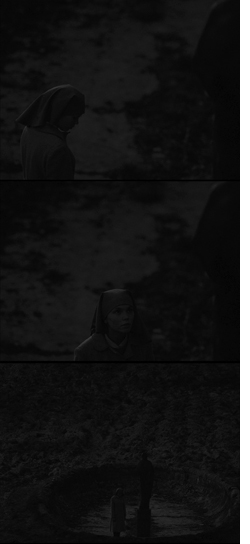 The exterior scene is composed of 2 shots:
The exterior scene is composed of 2 shots:
- A close shot of Ida pacing back and forth in the dark, then finally looking up.
- A wide shot that reveals that Ida is in the convent garden next to a statue of Christ that was seen at the very beginning of the movie.
Ida then speaks her only line of dialogue in the sequence of 6 scenes:
“I’m not ready. Forgive me.”
This is the culmination of the sequence, first Ida moves back and forth to show her agitated and indecisive state.
Then, alone in the darkness, Ida tells her God that she is not ready to become a nun.
![]()
Lukasz sought to light the night exterior as naturally as possible, and he says that this was one of the most difficult scenes in the movie, because he chose to shoot it as dusk for night.
Lukasz set up for the wide shot first, bouncing 2 6Ks and 1 4K into big frames on the Western side of the garden, to add a very soft direction to the light. He positioned these big fixtures far away from the action, about 40 meters, so as to not sense the sources in the frame. He relied on the sky to provide natural fill from the right. The camera was set up in the convent building as a high shot with a long lens.
The difficult part was balancing the bounced sources to rapidly darkening skylight. Speaking via walkie-talkies to electricians near the fixtures, Lukasz had them tilt the units downwards as the sky got darker, ending up with almost no bounce at all in the final take.
The crew then rushed the camera to the statue for the close-up of Ida. A 4×4 1/2 White frame was brought in behind the actress to provide backlight from the distant bounces, and a poly was used for fill. Lukasz laughs as he recalls how dark the close-up was. “I couldn’t see anything with my eye, I only saw it in the viewfinder”.
This scene is a very compelling and convincing night exterior. The choice of dusk for night implied shooting quickly and adapting to the natural light. I especially like that you can’t sense the sources in the wide shot because they’re so far away.
+++
another scene
To give another taste of IDA, I wanted to describe one more scene, when Ida dresses up to go to a club to listen to her musician friend play jazz. Although I don’t have an excerpt of the scene to show, you can see glimpses of it towards the end of the trailer:
watch on YouTube
+++
night club – night interior
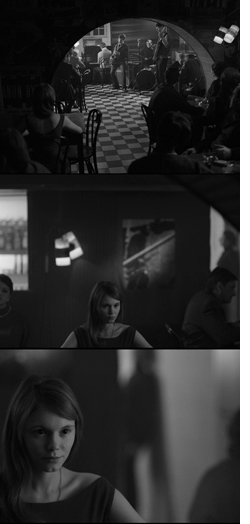
The club scene is composed of 3 shots:
- a wide shot from behind the audience watching the musicians play Coltrane’s love ballad Naima.
- a wide shot that reveals Ida in the audience wearing a dress
- a close-up of her, entranced by the music
Music plays an important role in IDA. There is an eclectic mix of 1960s pop songs, jazz and classical.
Mozart‘s Jupiter Symphony accompanies a key dramatic moment, and the film ends on a Bach cantata.
Here Ida is clearly taken by Coltrane’s ballad, which serves as a gateway to romantic love: in the next scene, she dances with the saxophone player.
![]()
The musicians were simply lit with 2 fresnel spots. The spot on camera left is a kind of soft key, shining through a frame of 1/2 White, the spot on camera right serves as a backlight for the band; a little smoke softens the image.
![]()
Lukasz lit the shots on Ida with practicals and 5 sources:
- The soft key is provided by a Compact Kino Flo bounced off a poly and then diffused through a frame of 1/2 White. This combination of bounce and diffusion is often called a “book light“; it can also be done by diffusing first and bouncing second.
- An Octodome serves as fill on camera left.
- A 2K fresnel is shone into a Full White frame behind a bar with a shelf of bottles, creating rectangle of soft shapes on the left of frame.
- Another 2K fresnel creates another, dimmer rectangle on the right of frame.
- The background center is defined by 2 practicals and a Dedolight on a poster of Coltrane.
The strength of the lighting relies on the delicate and sophisticated balance of different tonal values, and Lukasz put all the units on a dimmer board so he could fine tune the look for each take.
The shots on Ida offer a rich background, with variegated dark and bright variations, and the book light on Ida is ravishing, especially when the book light is brought in close to her for the close-up.Lukasz sums up the goal of this complex lighting set-up simply: “we wanted to make Ida look beautiful.”
This scene is a good example of an image that offers a full range of gray tones from black to white, an important lesson for cinematography in color as well as black and white.
+++
links
New York Times: An Innocent Awakened – Ida review by A O Scott
Hollywood Reporter: Ida review by Todd McCarthy
Music Box Films: Ida press page
Pawel Pawlikowski’s website
Lukasz Zal’s Vimeo channel
Lukasz Zal’s website
Arri Alexa 4:3
Dedolight: Octodome
YouTube: John Coltrane’s Naima
+++
My thanks to Lukasz Zal and Pawel Pawlikowski.
Thanks also to Brian Andreotti and Laura Kim.
Video and stills courtesy of Music Box Films & Lukasz Zal.
+++
+++
Part 1:
3 Scenes from IDA
+++
You may also be interested in
thefilmbook: Eric Kress Lighting Workshop 1
thefilmbook: DPs & Gaffers: Who Does What?
+++

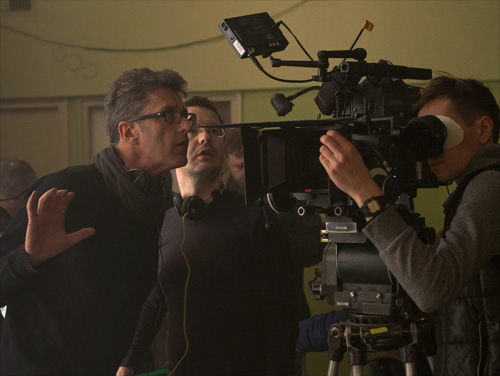
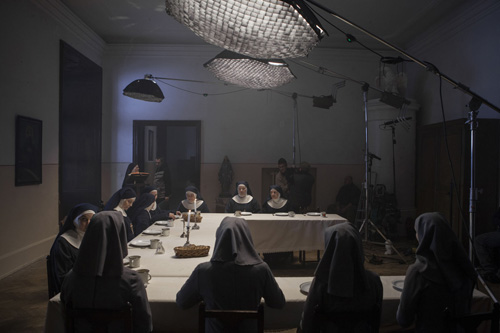
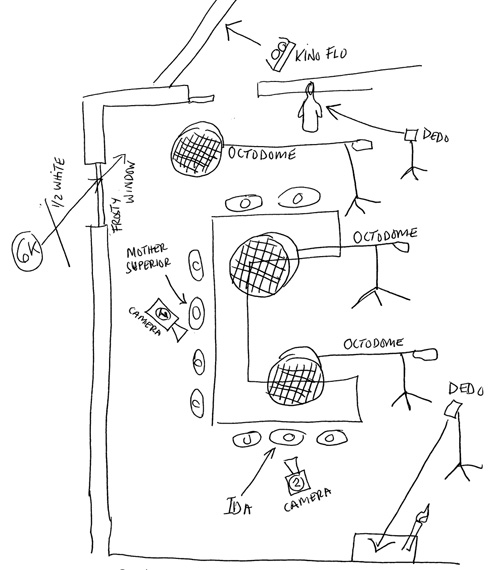
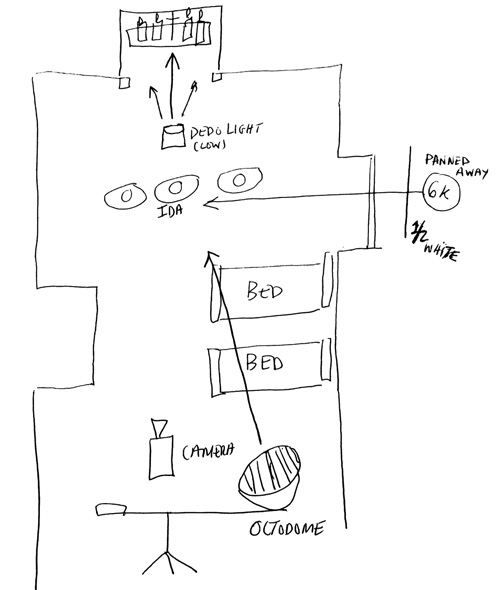
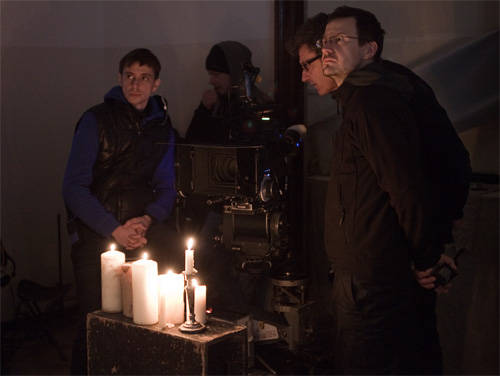
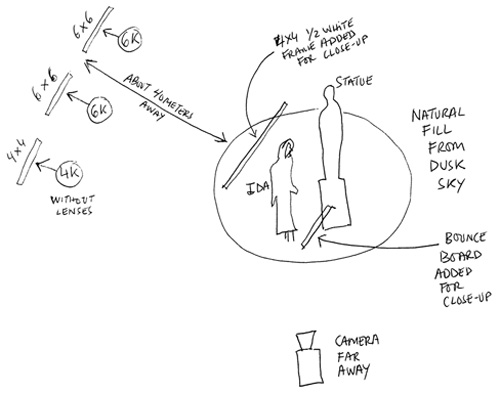


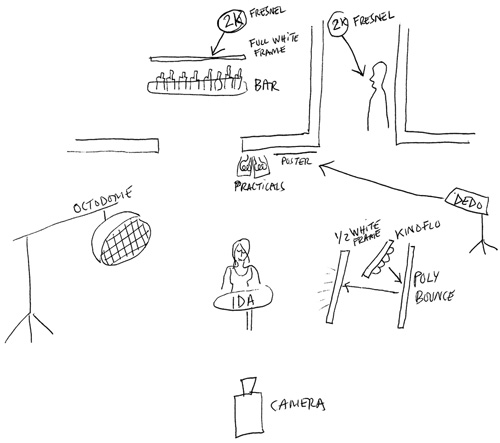
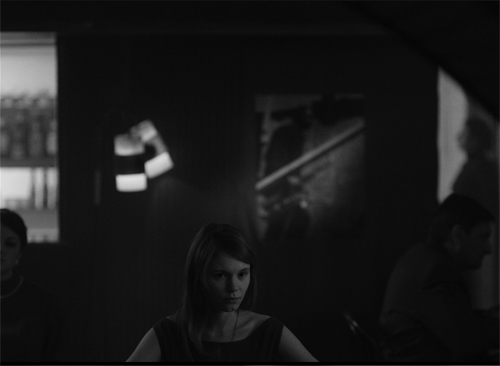
[…] Part 2: 4 More Scenes from IDA […]